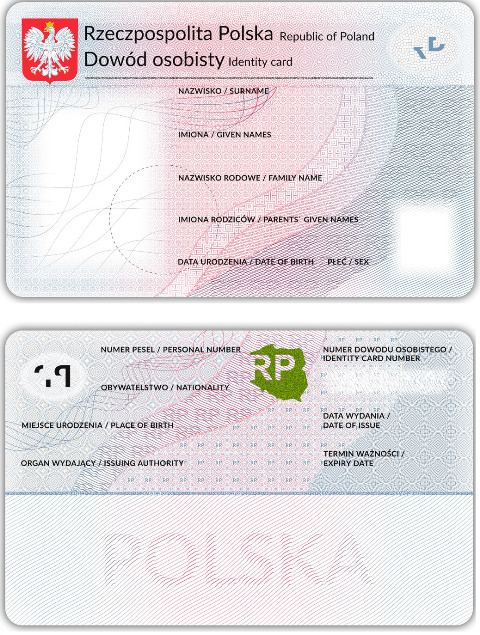Cost Free | ||
 | ||
Valid in Poland European Union member states European microstates EFTA member states CEFTA member states Georgia Jordan (organised tours through Aqaba airport) Gibraltar Guernsey Jersey Isle of Man Faroe Islands Greenland (de facto) French overseas territories Montserrat (max. 14 days) Northern Cyprus Type of document Identity card,travel document for passport in the listed countries Expiration 10 years (5 years if bearer aged less than 5 when issued) | ||
Every Polish citizen 18 years of age or older residing permanently in Poland must have an Identity Card (Dowód osobisty) issued by the local Office of Civic Affairs. Polish citizens living permanently abroad are entitled, but not required, to have one. Identity cards are valid for a period of 10 years (5 years for individuals under the age of 5 on the date of issue).
Contents
The front bears a photo of the holder, surname, forenames, date of birth, parents' names and gender. It also contains the coat of arms of the Republic of Poland and a security hologram. In the bottom right corner a special security element can be found - the photo of the person and the year of expiration, but only one of them can be seen at a time, depending on the angle of view.
On the back can be found the holder's nationality, place of birth, date of issue, date of expiry, card number, issuing authority and personal number (PESEL - Powszechny Elektroniczny Spis Ewidencji Ludności - Universal Electronic Population Database). Below the card number is repeated the bearer's photo and some of the personal data in machine-readable form.
The Polish identity card also functions as a travel document inside the European Union and, additionally, the non-EU-member countries within the Schengen area of Norway, Switzerland, Liechtenstein, Vatican City, San Marino and Monaco. Bosnia and Herzegovina, Albania and Northern Cyprus allow Polish citizens to use the card for travel as well.
Validation
The card number consists of 3 letters followed by 6 digits (for example, ABA300000), of which the first digit (at position 4) is the check digit.
Each letter has a numerical value, as shown below:
A B C D E F G H I J K L M N O P Q R S T U V W X Y Z10 11 12 13 14 15 16 17 18 19 20 21 22 23 24 25 26 27 28 29 30 31 32 33 34 35The next step is to multiply each so obtained value by its respective "weight". The assigned weights for each position are
1 2 3 4 5 6 7 8 9 7 3 1 0 7 3 1 7 3The remainder of the division by 10 of the sum of the weighted values should be equal to the check digit (indicated between asterisks in the example below).
Verification example (ID card number for this example: ABA300000):
Card number: A B A *3* 0 0 0 0 0Value: 10 11 10 *3* 0 0 0 0 0Weight: 7 3 1 0 7 3 1 7 3Result: 70 33 10 0 0 0 0 0 0Sum: 70 + 33 + 10 + 0 + 0 + 0 + 0 + 0 + 0 = 113The remainder of the division of 113 by 10 equals 3 (113 mod 10 = 3), and is also equal to the first digit of the ID card number, so this ID card number is correct.
Security features of the 2015 issue
Obverse side: At the top-centre the small map of Poland changes colour between green and violet depending on the viewing angle. There is micro-printing in the card's background which reveals "RZECZPOSPOLITAPOLSKA" when magnified. Both the family name and date of birth have a special raised feel
